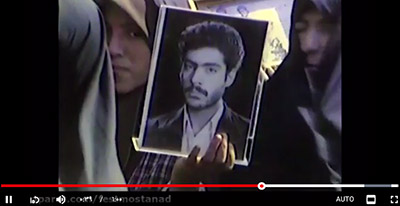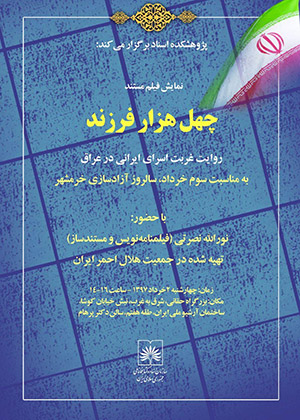About the documentary "Forty Thousand Children"
A Step toward Oral History of Red Crescent
Leila Karimi
Translated by: Fazel Shirzad
2018-6-12
Documentary "Forty Thousand Children" with a narration of the loneliness of Iranian captives in Iraq, in the presence of Noorullah Nosrati, the director of this documentary, was shown in Dr. Parham's salon at the National Library and Achieve of Iran on Khordad 2, 1397(May 23, 2018).
According to Iranian Oral History website, this documentary is narrated in four episodes by showing moments and bitter memories of captivity in the prisons of Saddam’s Army. The documentary "Forty Thousand Children", produced in Iranian Red Crescent Society, won prize at the first Red Crescent Festival named "Conjoint Crescent" and was honored.
At the beginning of meeting to watch and review of this documentary, which was held by Institute of Iran's National Library and Achieve, Noorullah Nosrati, director of documentary "Forty Thousand Children", referred to the neglected section of the holy defense culture, and added:" Despite historical dimensions and the ups and downs of eight years of holy defense – not only it was a huge event on a national level, but also on an international level- the subject of holy defense is not exhausted. Of course, many activities have been carried out by the Office of Resistance Literature and Art or Holy Defense Cinema Association, but, in my opinion, part of holy defense associated with the captives are in double suffering."

Nosrati called Iranian captives of Saddam’s imposed war as "The Hidden Bulwark of War", according one of the captives narrated. He added: "There is a more secretive history that has never been seen; it is the activities of Red Crescent Society that has been associated with captives and their families in a particular perspective, and its legal and organizational duty was to investigate the situation of Iranian captives in the camps of the Ba'ath regime of Iraq."
Nosrati referred to Red Crescent's motivation for making this documentary, and emphasized: "The special role of Red Crescent organization in sacred defense with its national dimension remains untold. This film was a response in the heart of larger and more obscure dilemmas of captives."
The director of the documentary "Forty Thousand Children" considered oral history as an impartial observer, and said:" Oral history narrated the dark parts of history. As an oral history activity, I made a documentary in the form of oral history and part of Red Crescent Organization using visual and audio tools to investigate the captives."
He did not consider any of plans and photos of the camps of the Ba'ath regime of Iraq reconstructed, and added: "The documentary is intended to be based on the Interactive Documentary format (communicative and documentary) of oral history and documentaries about the prisons and camps of Iraqi Ba'ath Army from French and Iraqi Television Archives. Different people talk about a historical event, and ultimately, an attempt was made to put forward all the views. There are lots of untold words about the captives, we took the first step and I'm glad that this documentary was broadcasted at the National Library and Achieve of Iran."
Following the speech of the director for the documentary "Forty Thousand Children", a six-minute documentary about the release of Khorramshahr which was made by the same director, was screened. In the part of this documentary film, one of the rescuers in Khorramshahr told a memory as follows:" One of our bitterest days was on Mehr 9th 1359(October 1st, 1980); there were wave of explosions from the earth, the sky, sea and from each side. It was one of my relief experience that we encountered with a wave of people and families. I thought that hospital was a safe place, we moved all of them to the hospital; unfortunately, the emergency unit of hospital was the first place shot by enemy; our causalities were heavy. We took people among palms near river, which was as a camouflage. Boats was the only thing that helped us at that moment. It was left by people on the bank of Karun[1]. When it was night, we put the boats together and built a bridge. This is a memory that nobody may have known, because no one looked at back. My duty was to help. Khorramshahr was fallen on the fourth day of Aban 1359(October 26th, 1980). When the news of the fall of Khorramshahr arrived at the camp, it became like Karbala[2] entirely. Khorramshahr no longer existed. It was hard to believe…"
Subsequently, the documentary "Forty Thousand Children" was broadcasted in four episodes for an hour. The first episode named "The Prison of Hajjaj[3]" narrated human rights violations by Ba'ath regime in the eyes of eyewitnesses. In this episode, Kamal Kharrazi, the current head of the campaign's headquarters in 1364(1985) said: "The representative of International Committee of Red Crescent visited all patients in clinic; most of them were suffering from fatal injuries and false therapies especially bone fractures of hands and feet that was welded badly and caused bone infections. At the same meeting, 200 to 400 soldiers beat somebodies, who had been brought from another area to camp, with wickets and cables resulted in 80 injured and three martyrs, and Red Cross entered contest for death certificate that was issued by Iraqi government."
The second episode "Crescent Garden" depicted the captives and lost persons of Red Crescent Organization. In this episode, Behjat Afraz, the head of Office of Captives and Lost Persons, and Najmeh Hassanpour, the head of the Office of Search and Resettlement of Families at Red Crescent, told their memories about the captives’ and the lost captives’ families. Hassanpour remembers the days when the captives returned to Iran and the lost persons’ family took the photos of darlings in hand and said repeatedly: "You did not see my child and ..."
In the third episode named "White and Red Harbingers", some letters was exchanged between captives and their families, and Behjat added:" from the start of war to the great liberation, we exchanged about six million letters in the office."
In the fourth episode named "The Portrait of Mrs. Afraz" and it was about activities and personality of Behjat Afraz who was head of Captives and Lost Persons of Red Crescent. In this episode, Fariburz Khobnejad, who was one captives of sacred defence, said:" Mrs. Afraz was my mother and she had forty thousand children. She was called" The Mother of Captives" by Hajjagha Abutorabi."

[1]It is Iran's most effluent and only navigable river
[2] Karbala is a city in central Iraq in where imam Hussein (PBHM) and his comrades were martyred in 61 AH (October 10, 680 CE)
[3] Somebodies who traveled to Mecca to visit Kaaba
Number of Visits: 4056








The latest
- The Necessity of Standardizing Oral History and Criticism of General Mohsen Rezaei
- The 368th Night of Remembrance – Part 1
- Oral History News of Khordad 1404 (May 22nd – June 21st 2025)
- Najaf Headquarters Human Resources
- The Embankment Wounded Shoulders – 12
- Annotation
- The 367th Night of Memory– 5
- The Founder of Hosseiniyeh Ershad
Most visited
Operation Beit al-Moqaddas and Liberation of Khorramshahr
After Operation Fat’h al-Mobin, we traveled to Kermanshah and visited Sar-e-Pol-e-Zahab before heading to Ilam. During Operation Beit al-Moqaddas, the 27th Brigade was still receiving support from the West. We maintained contact with individuals who had previously worked in Area 7 and were now leading the brigade. It was through these connections that I learned about Operation Beit al-Moqaddas.Memoirs of Hujjat al-Islam Reza Motalebi
Hujjat al-Islam Reza Motalebi is a cleric from Isfahan. Before the revolution, he was the imam of the Fallah Mosque – which was later renamed Abuzar Mosque. By his presence and efforts, Abuzar Mosque soon became a base for supporters of the Imam and the revolution. After the victory of the revolution, he played a role in uniting forces and maintaining political vitality in southwest Tehran.The Necessity of Receiving Feedback in Oral History
Whenever we engage in a task, we naturally seek ways to evaluate our performance — to correct shortcomings and enhance strengths. Such refinement is only possible through the feedback we receive from others. Consider, for instance, a basketball player whose shots are consistently accurate; should he begin shooting blindfolded, his success rate would rapidly decline, as he would be deprived of essential feedback from each attempt.Sir Saeed
The book “Sir Saeed” is a documentary [narrative] of the life of martyr Seyyed Mohammad Saeed Jafari, written by Mohammad Mehdi Hemmati and published by Rahiyar Publications. In March 2024, this book was recognized as one of the selected documentary biographies in the 21st edition of the Sacred Defense Book of the Year Award. The following text is a review on the mentioned book.

